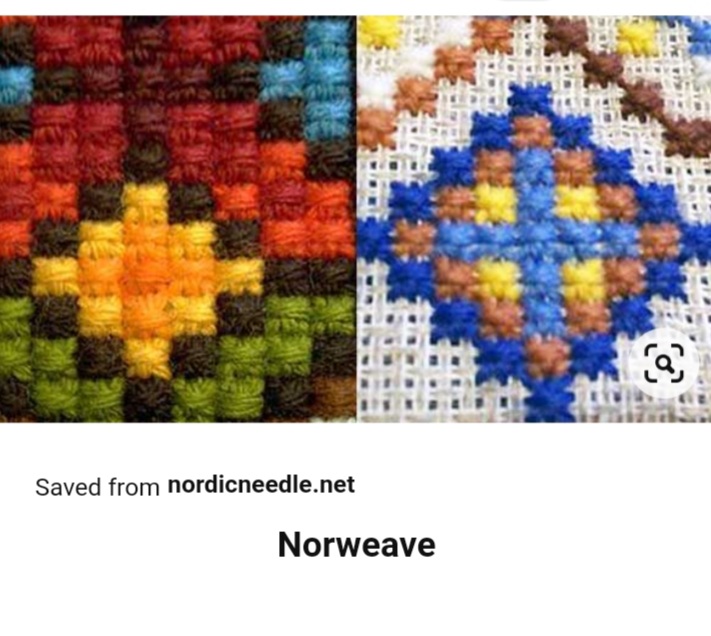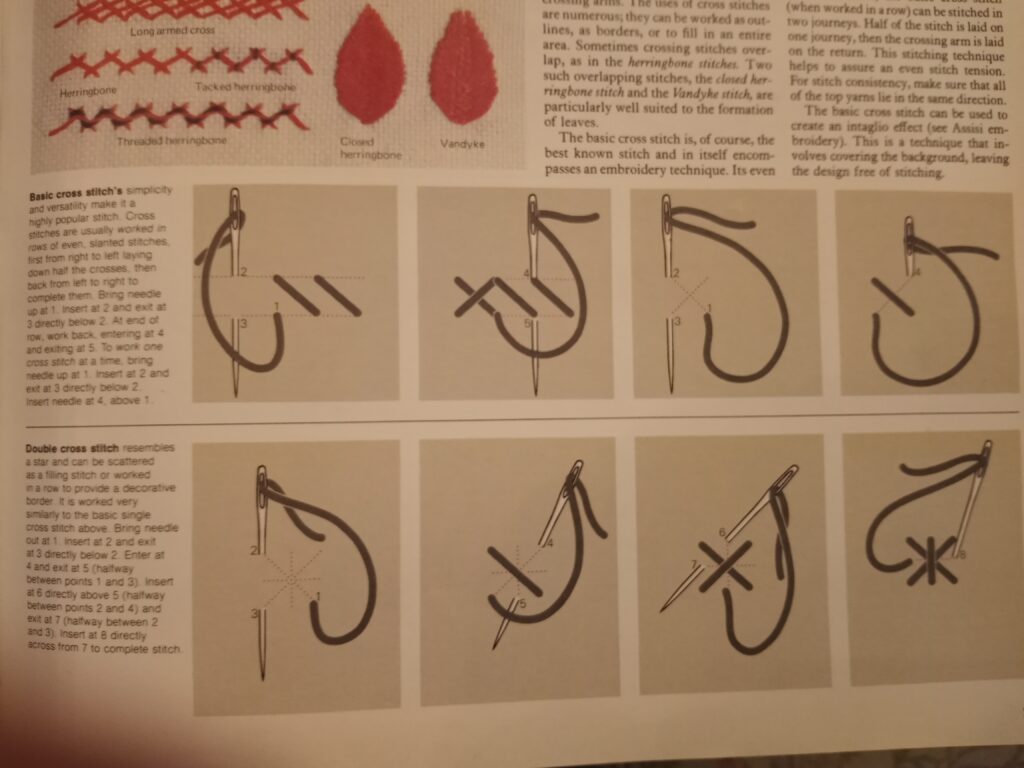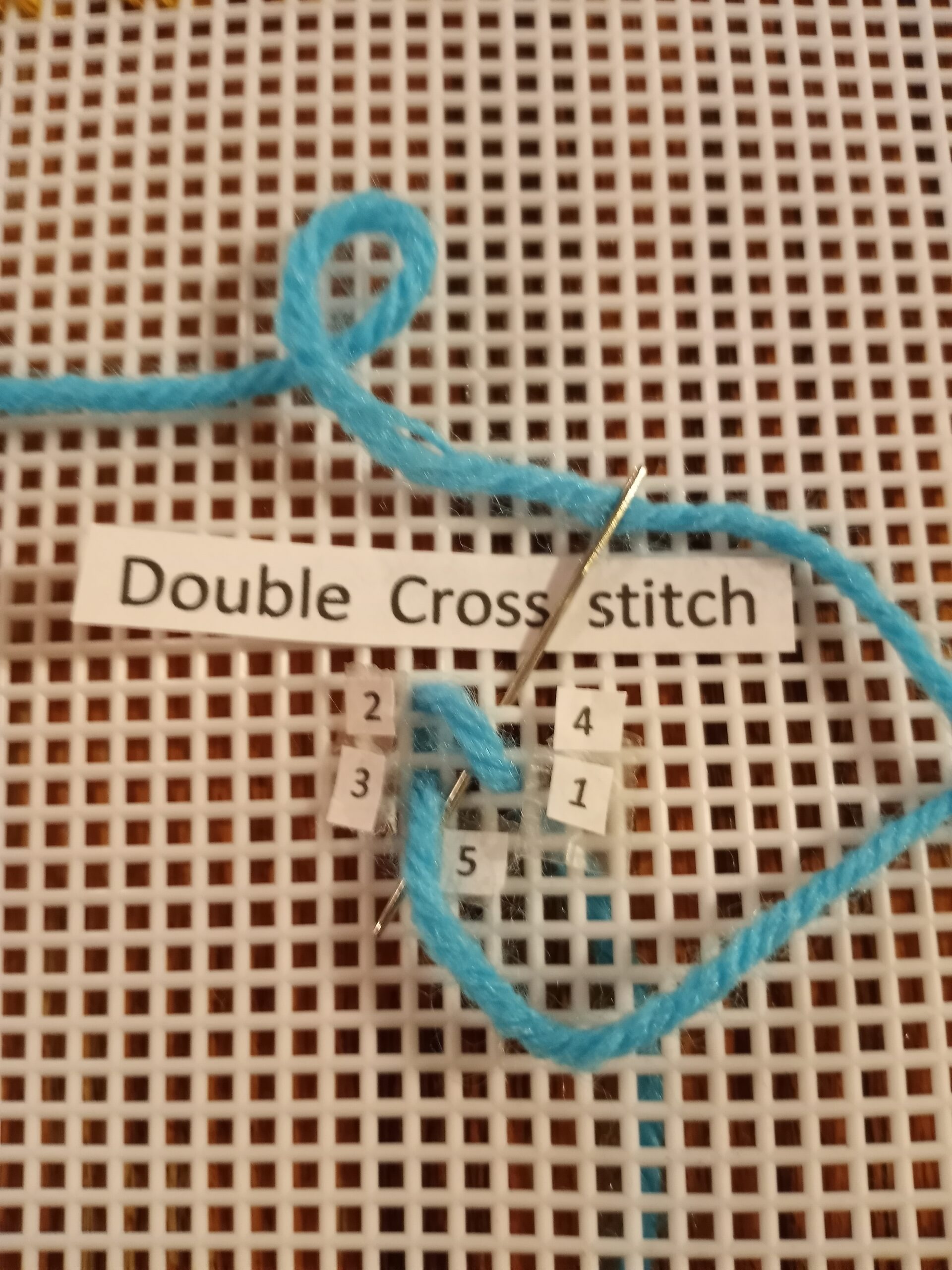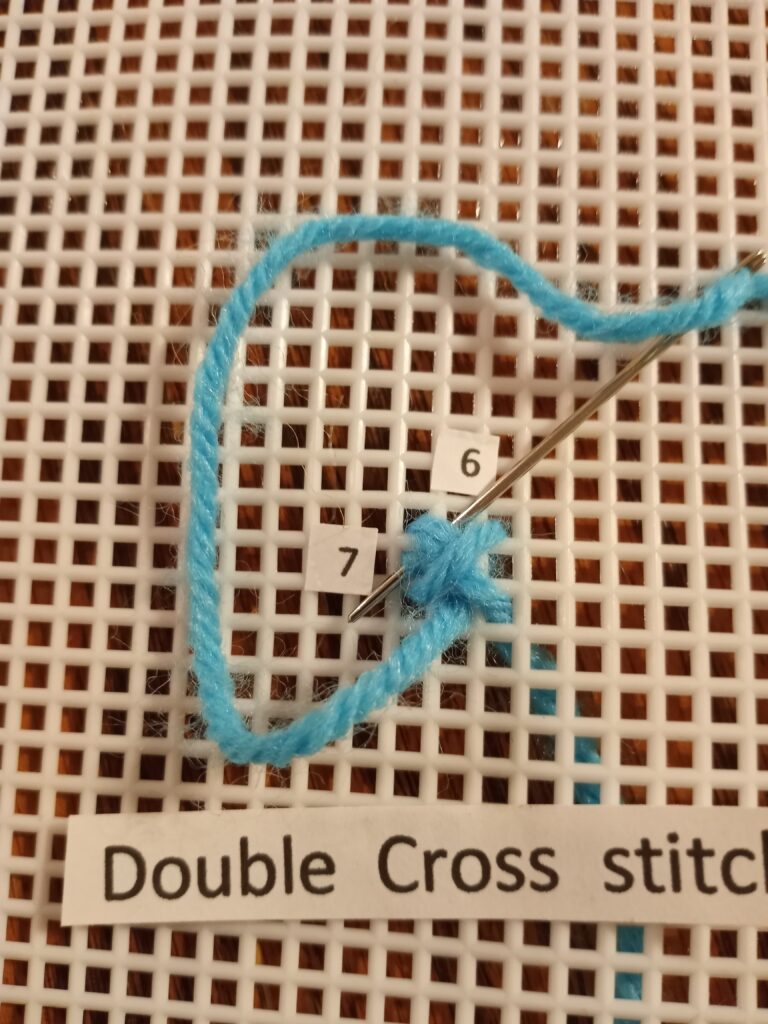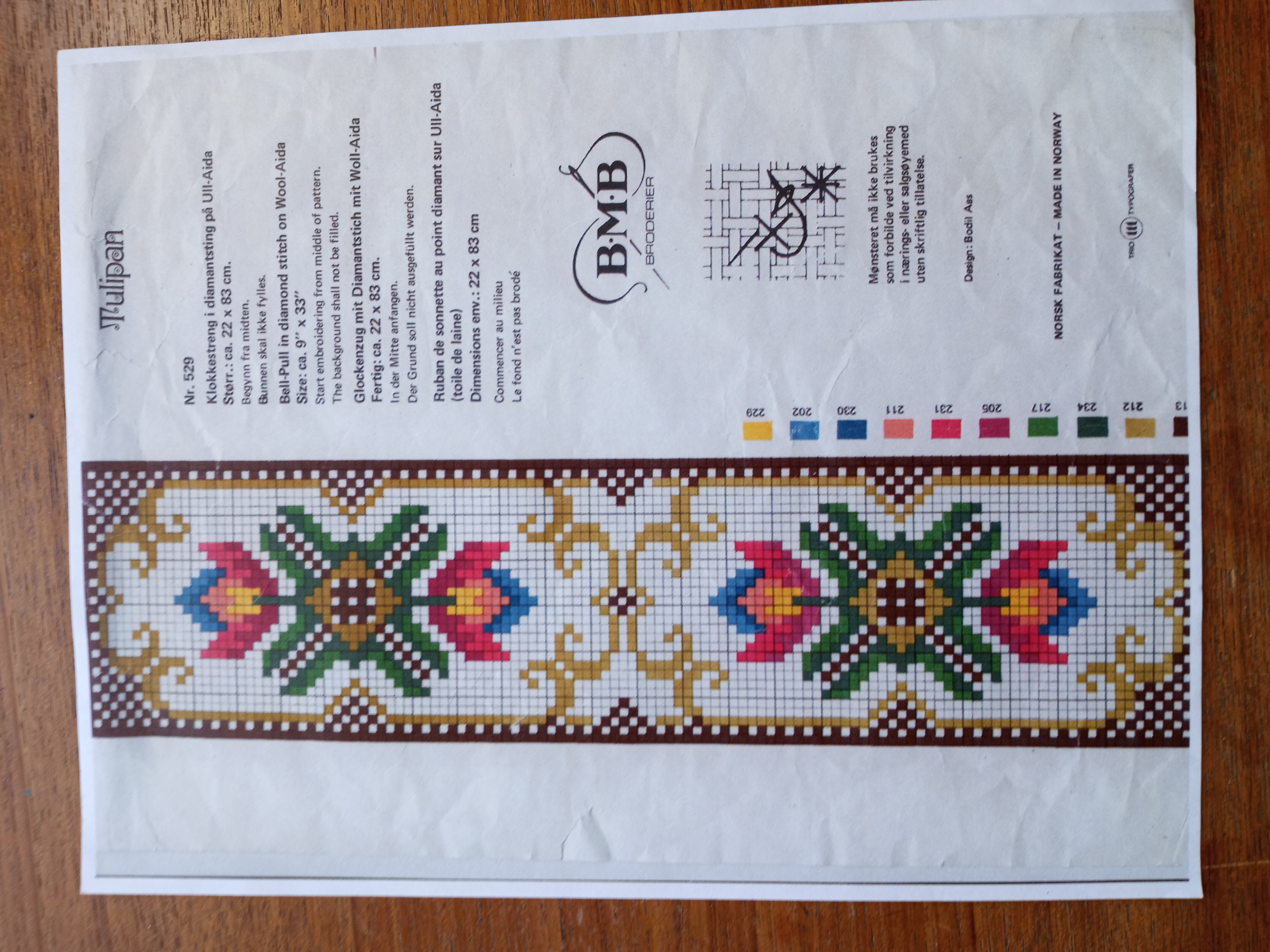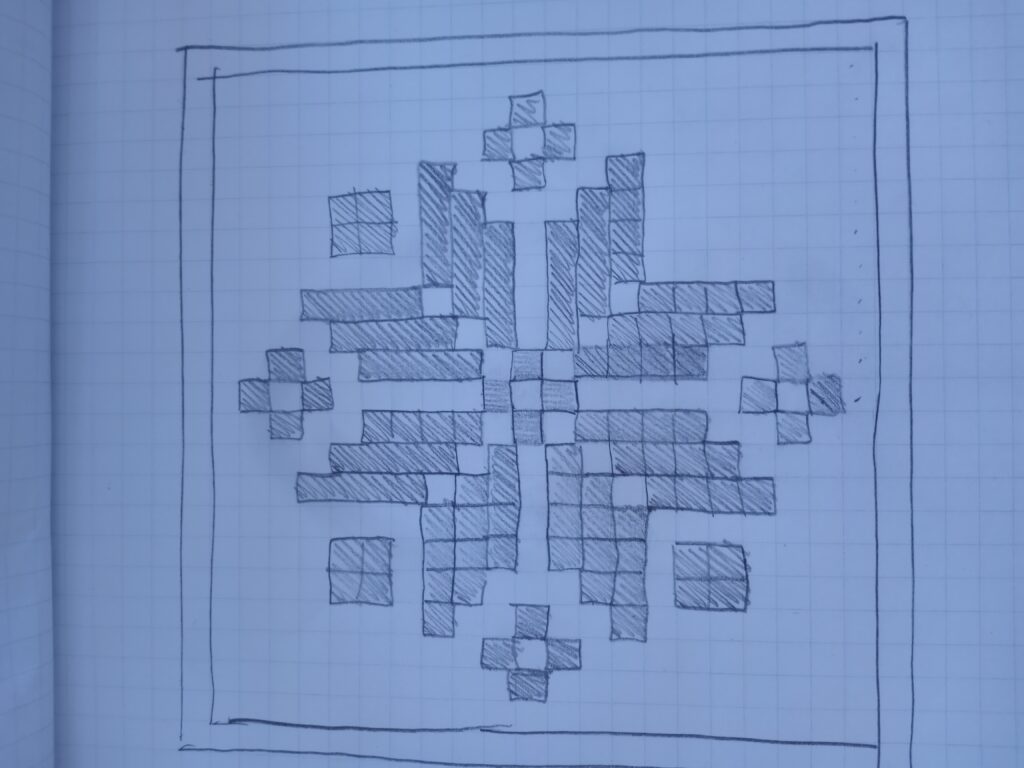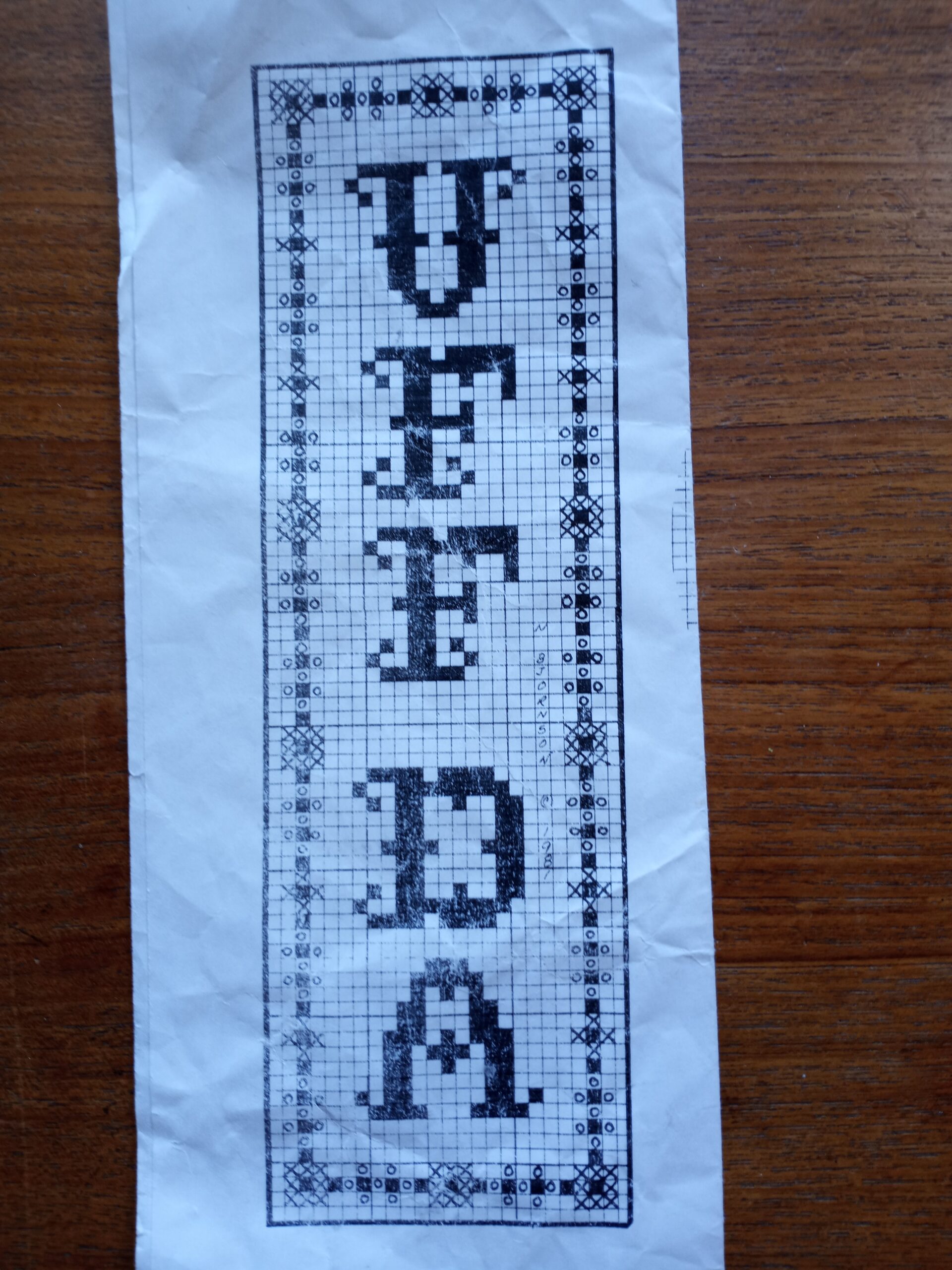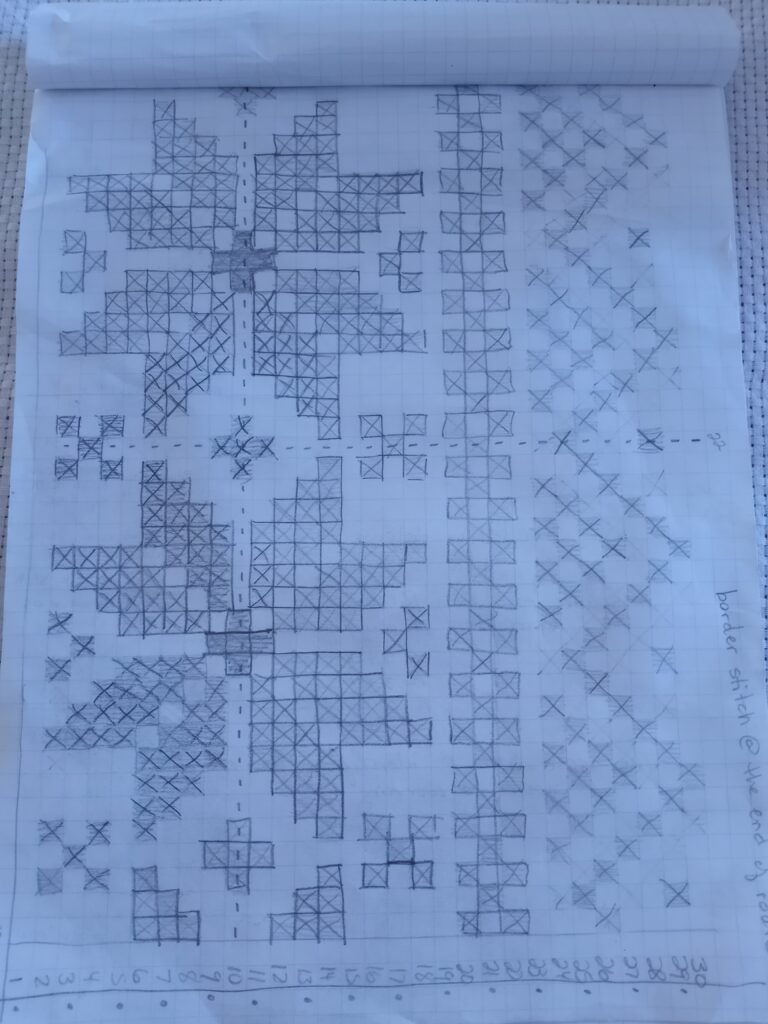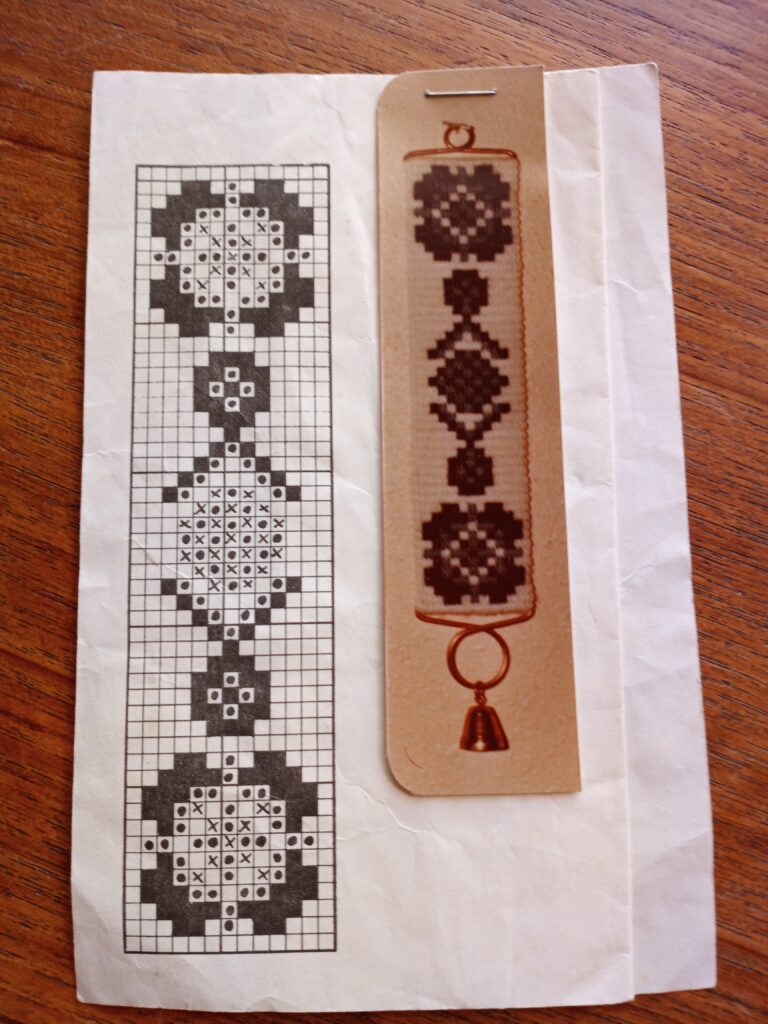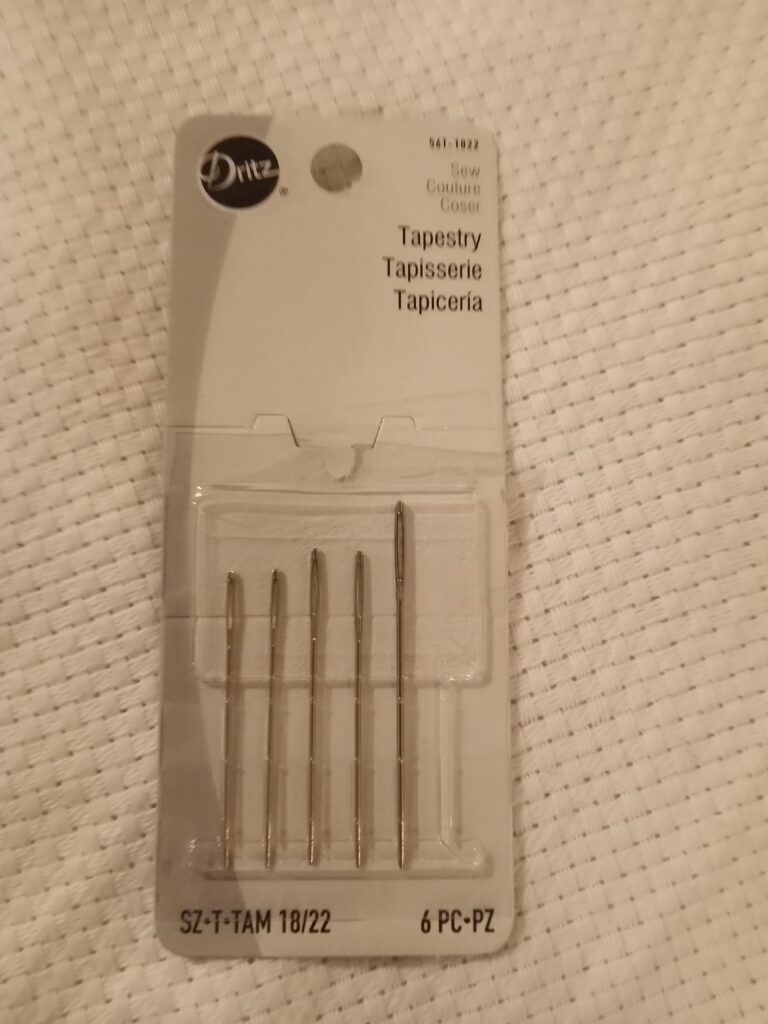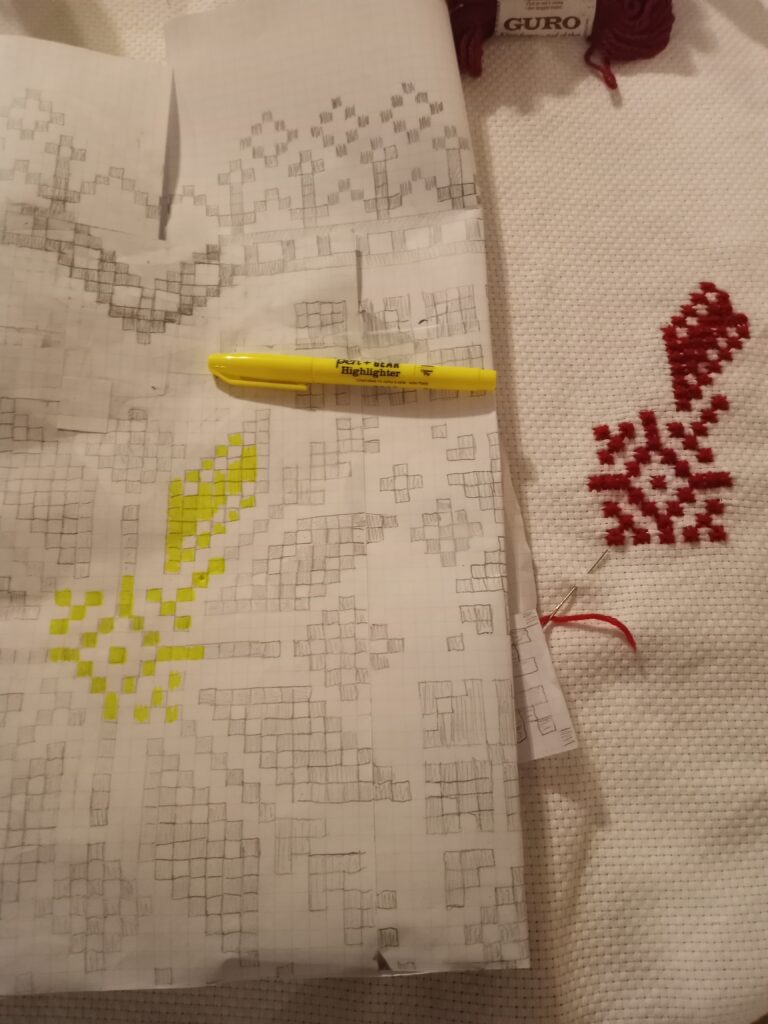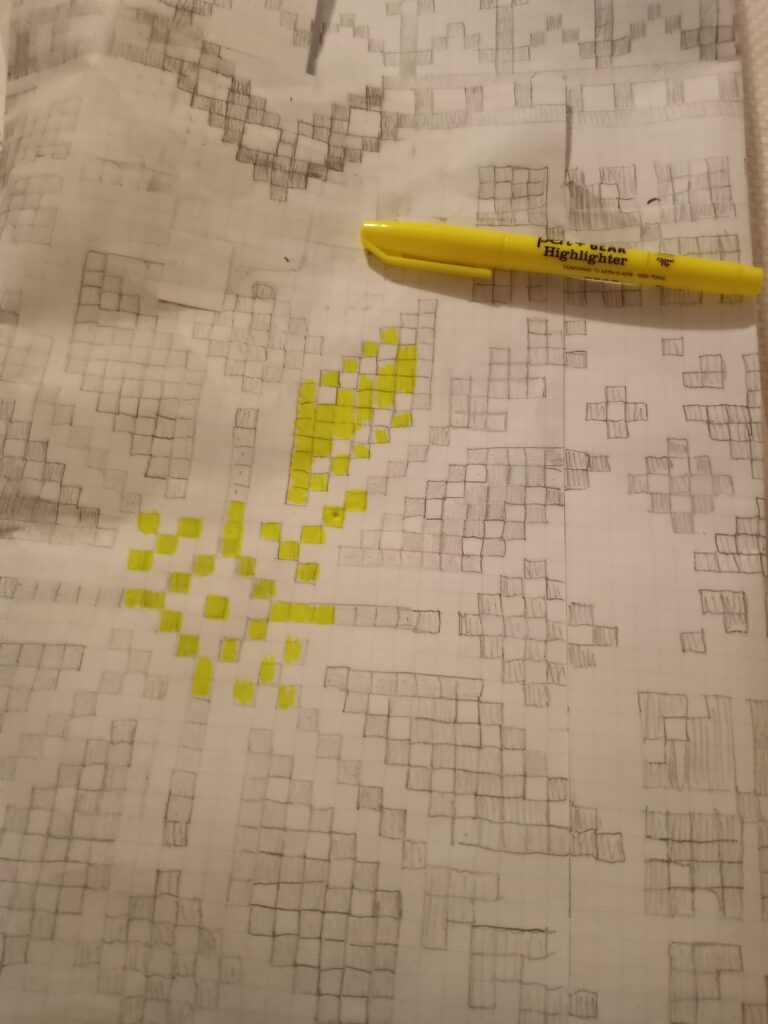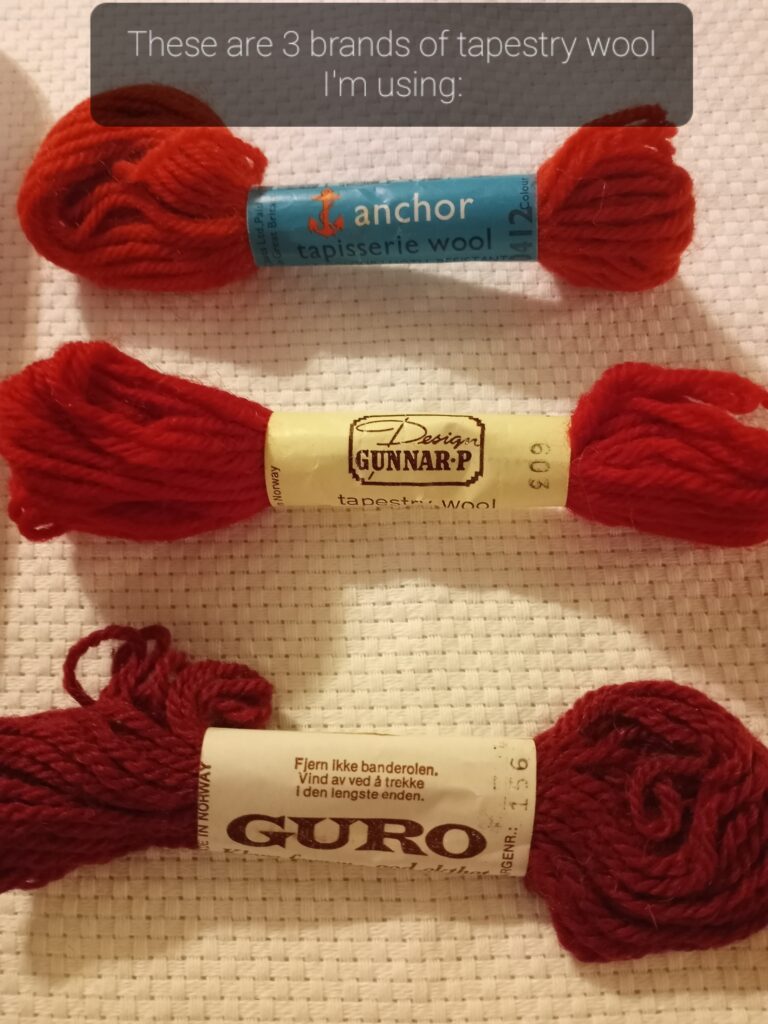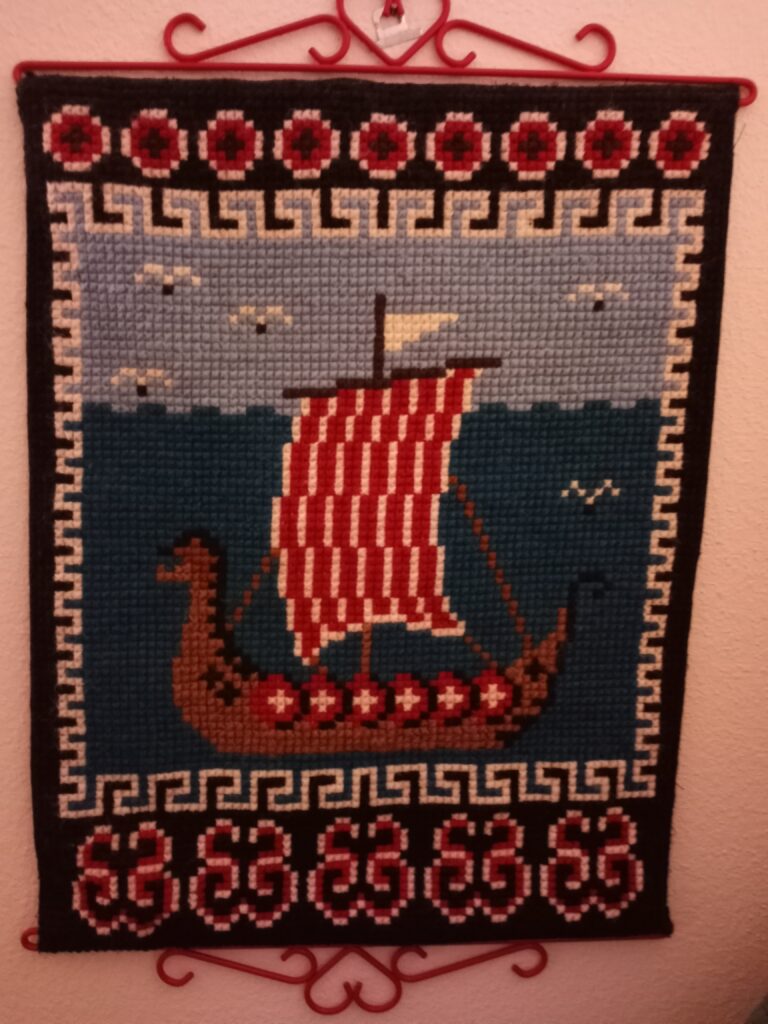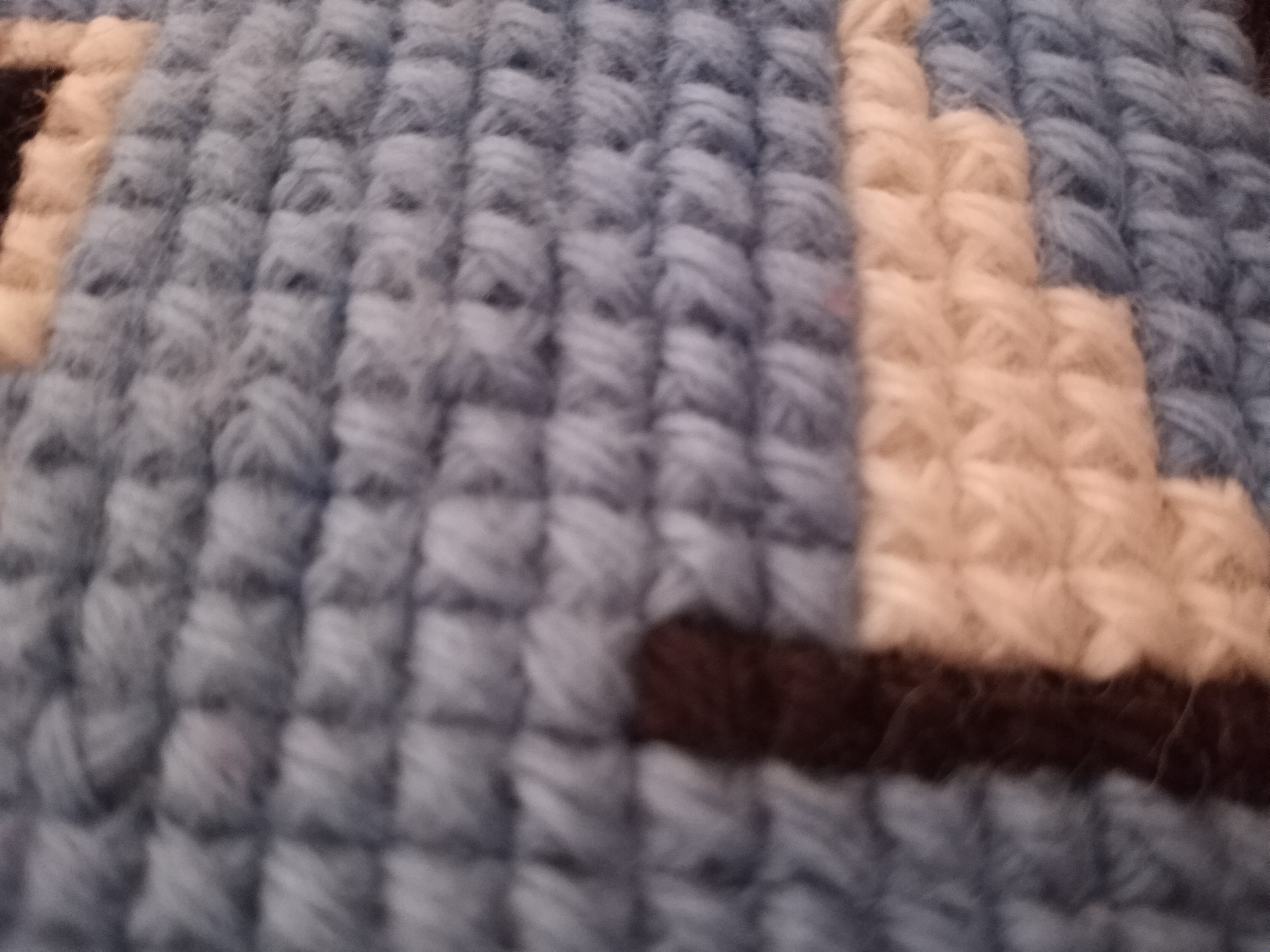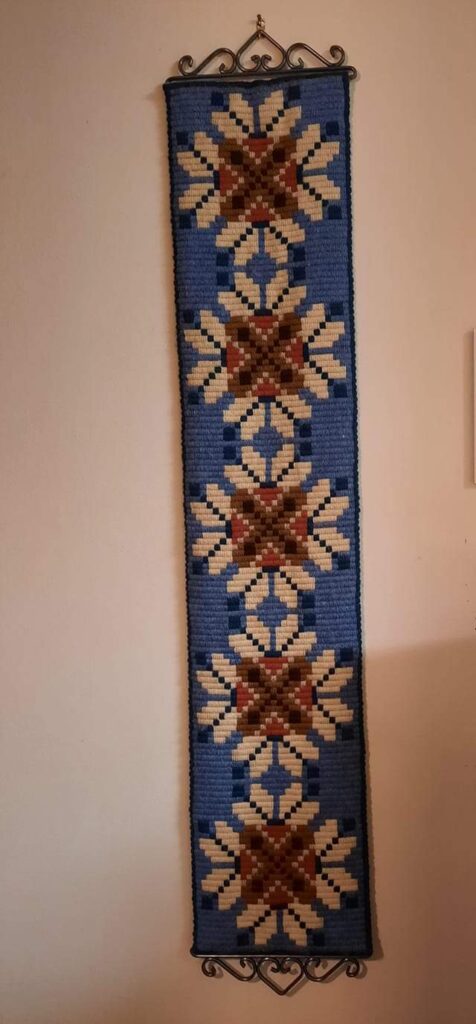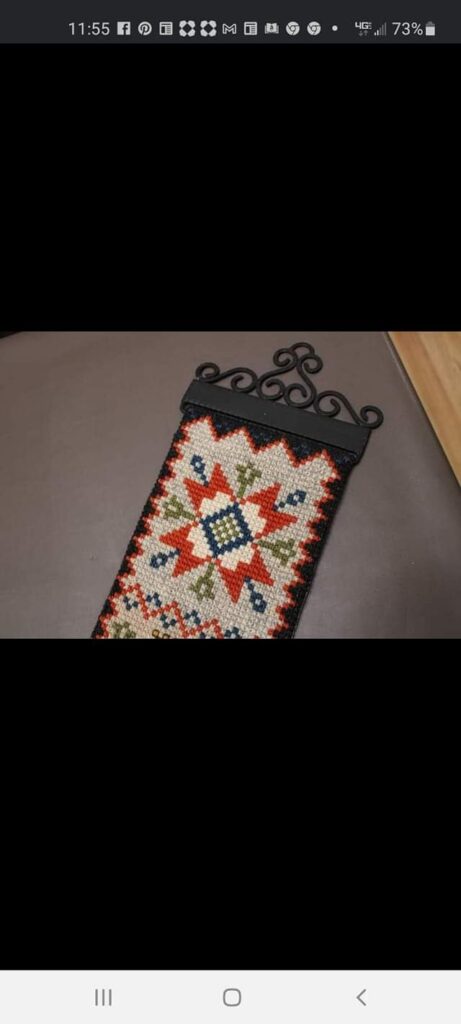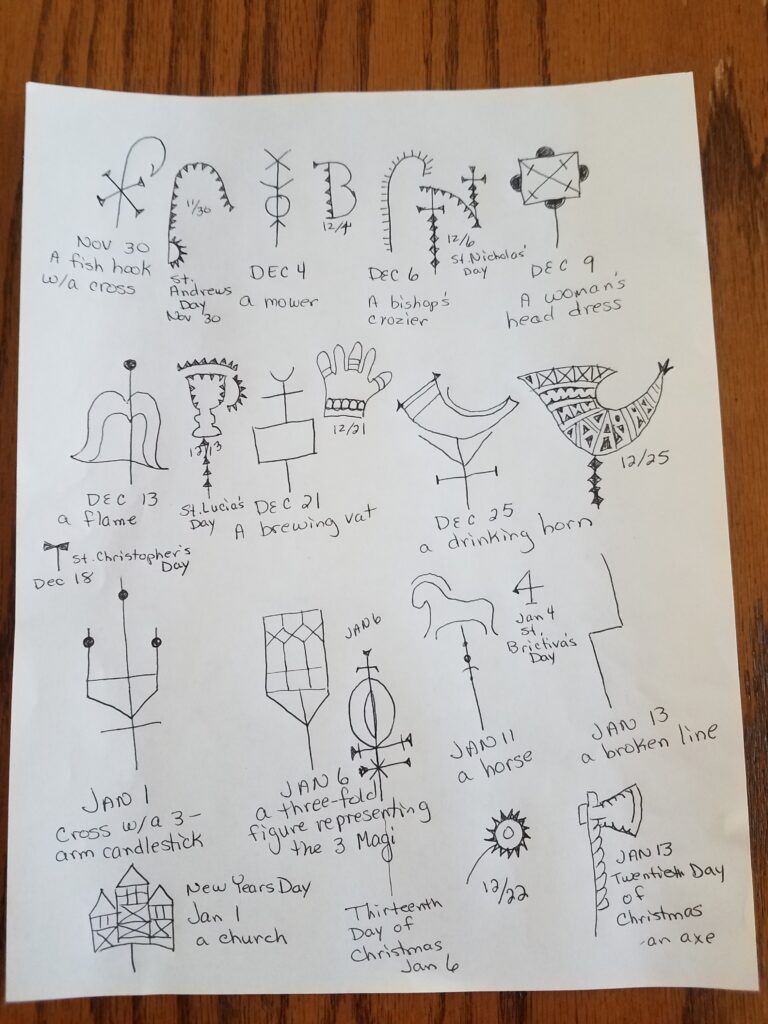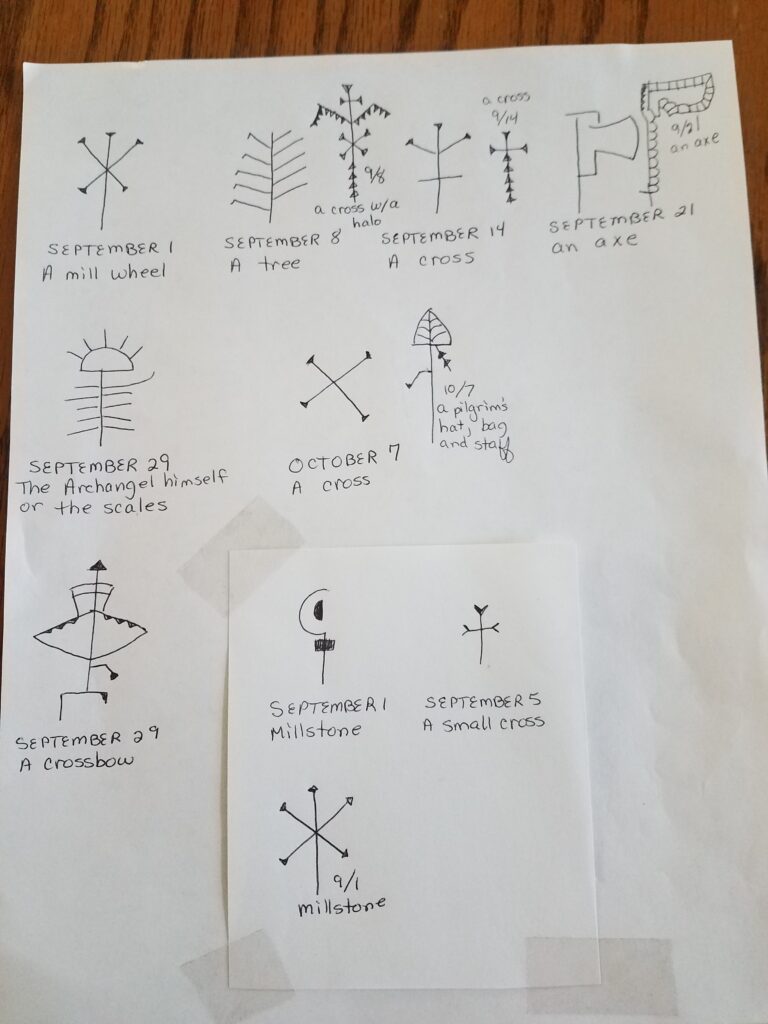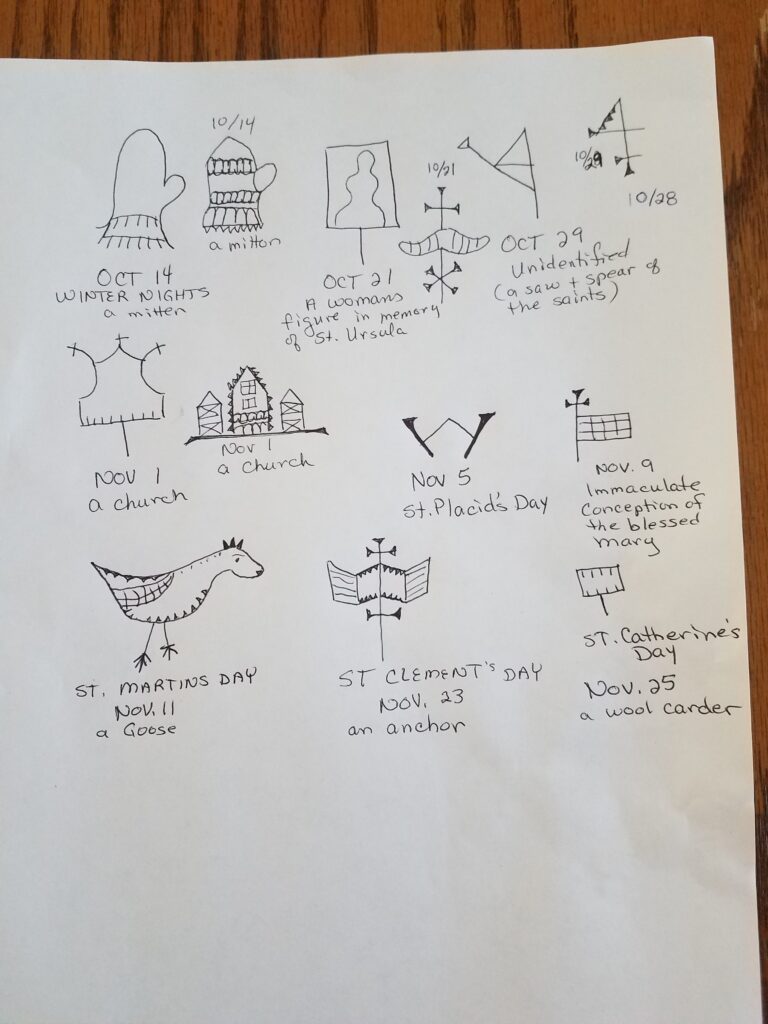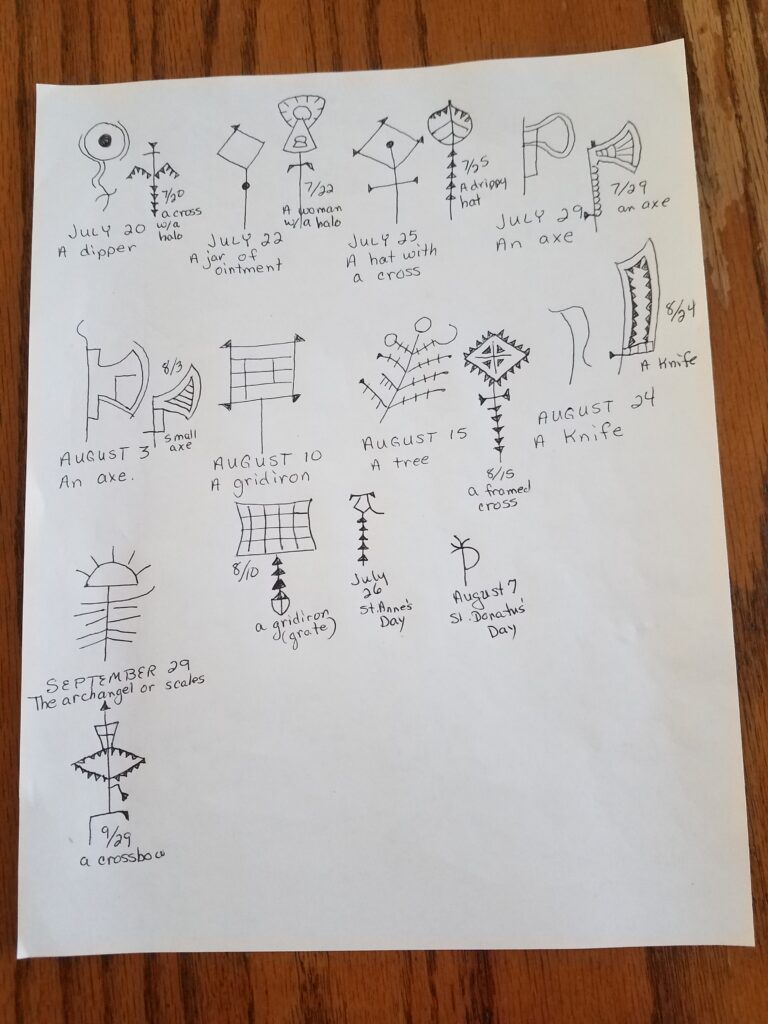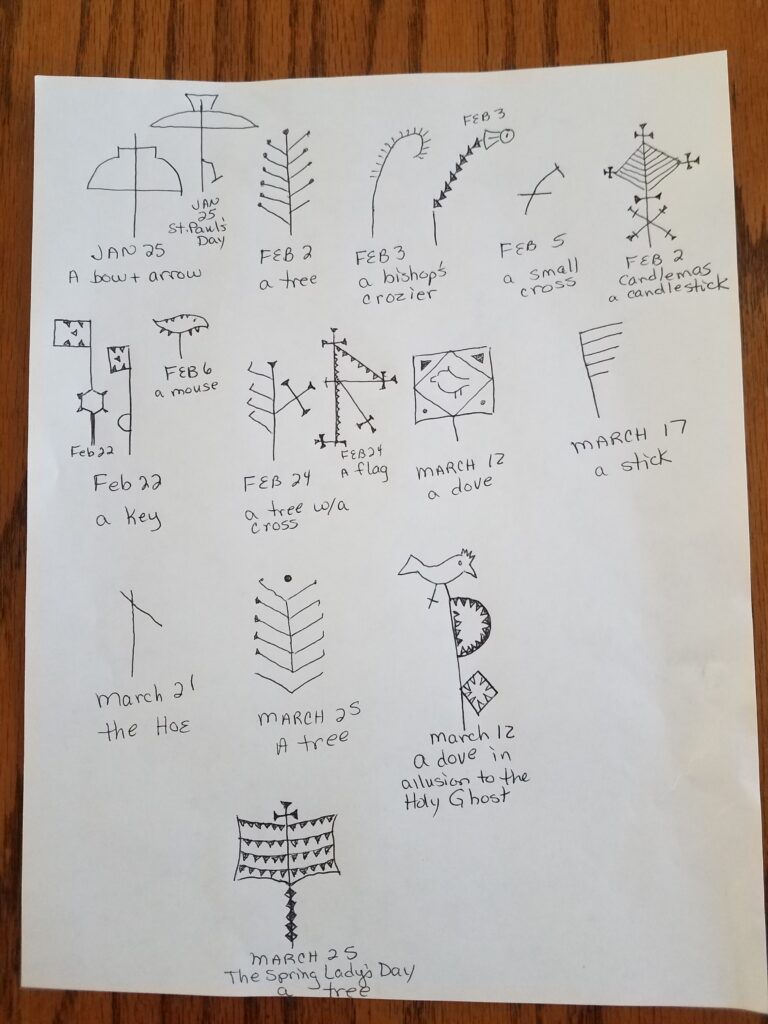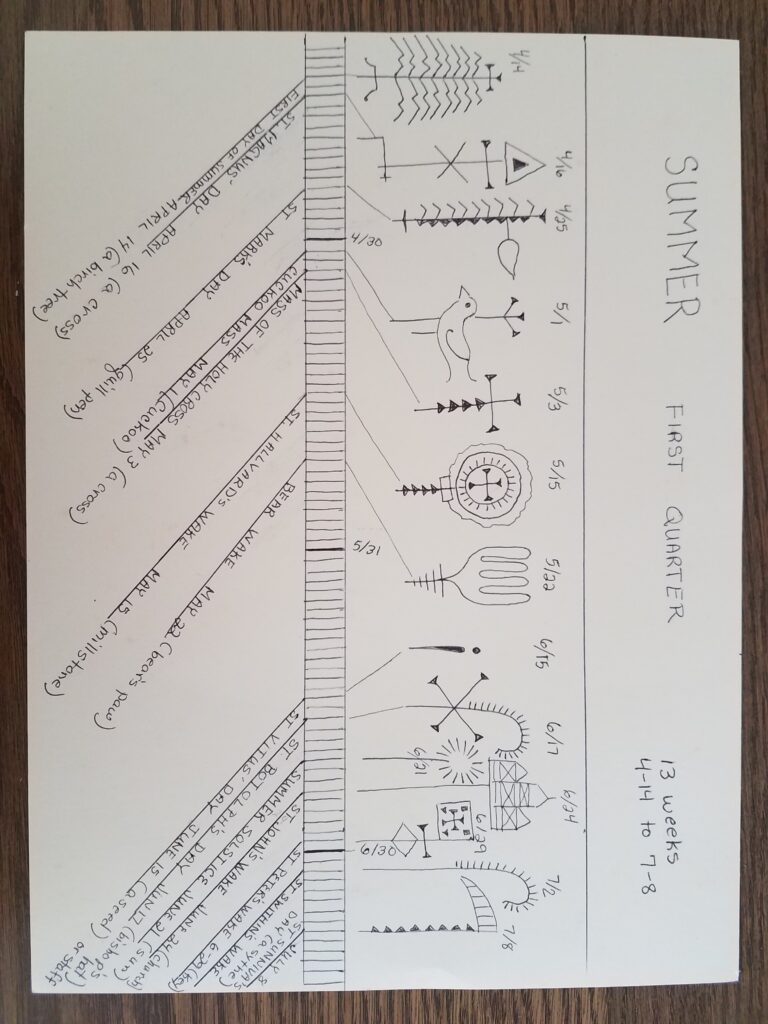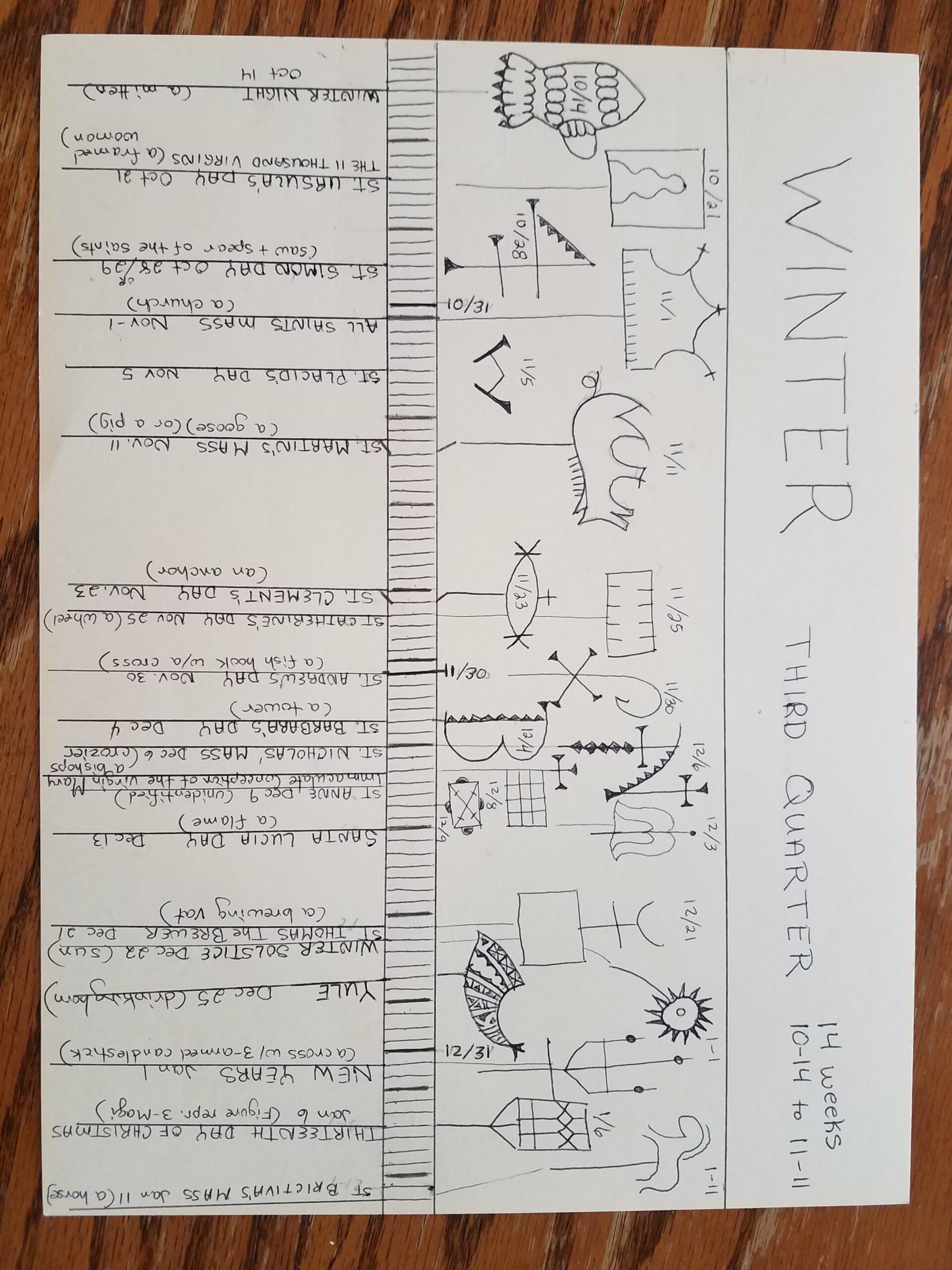SUMMER (14 April – 13 October)
April 14- FIRST DAY OF SUMMER Symbol: evergreen tree.
This day honored two martyrs, the brothers St. Tiburtius and St. Valerianus, who died in 229.
The symbol is a tree, signifying the renewal of life. If it snowed this day, it would snow nine times before summer came. Soil was thrown onto the fields to make the snow melt faster. All milking vessels should be thoroughly scrubbed. In many parts of Norway, servants were hired on this day. Shepherds abstained from meat on this day, believing that if they are meat, it would harm their herd, lest wolves and bears devour the cattle.
This is a special day in which is inherited from the time before Christianity. Right up until recent times, work was prohibited on this day. In other regions, it was considered half holy. In the area of Ostlandet, they ate
Summer porridge. In Valdres, the livestock was supposed to have been brought forth, and everywhere they would prepare for Summer in the mountains (bu=seter). In Hordaland, close to the coast, it was the first day of seeding.
As the weather was on the first day of Summer, so it would be for three weeks (Verdal) or for seven weeks (Beistad). Throughout the country, frost and snow predicted a cold and poor Spring, while warm weather predicted a good Summer. As the weather was the first day of Summer, the crop would be in the Fall (Gudbrandsdalen). A clear Summer day meant that the year would be good (Seljord). If it snowed on the first day of Summer, there would be nine days extra with snow before the Summer really came. Other names for the day: Summer Night, Summer Measure, The Day of Summer Measure.
April 16 -ST. MAGNUS’ DAY
Symbol: a slanting arrow or axe (the saint’s attribute) or a hoe (the beginning of spring work).
This day Commemorate the Earl, Magnus, from the Orkney Islands. St. Magnus was murdered by his cousin Earl Haakon Paalson in 1115. In the year 1135, he was canonized. A cathedral built in his honor at Kirkwall by his nephew, Earl Ragnvald, is still standing.
His symbol was an arrow or an axe, but here it has been changed to a spade, scythe or a hoe. That was probably in line with the lore that this was the day to begin cultivating the fields.
April 25- ST. MARK’S DAY (Markusdagen) Old Summer Nights (Gamle Sommernet)
Symbol: quill pen or a lion
It was a memorial day for the evangelist (St. Mark the Evangelist) Marcus who was martyred in Alexandria. On this day, pagan people would make sacrifices to the Norse gods for their victory over Tjasse, the evil spirit of winter. The people and their priest walked in procession with crosses and relics across the fields while the priests sprinkled holly water to ward off evil spirits and calling for the blessing of God on the fields and the summer crop.
Although Mark’s symbol is a lion, the symbol in this case may be a quill pen in reference to Mark’s writing one of the gospels. This is another example of how the Church took pagan customs and gave them a different meaning. Another interpretation of the symbol is that of a spikelet (or a field) with a road around it.
According to the Old Style (Julian) Calendar, this was the opening day of summer. Bells should be fastened on the cows; the making of butter and cheese could begin.
May 1-*CUCKOO MASS / GAUKSMESS
Symbol: A Tree with a Cuckoo
This day has possibly been given the name after the first month of Summer in Old Norse – the cuckoo month as it is called in Snorre’s Edda. The marker on the calendar stick is a cuckoo bird or, as on some calendar sticks, a double cross. In the church calendar it was a memorial day for the Apostles Philip and Jacob. One may also find the name Valborg’s Mass – in memory of the holy Walpurgis. In southern Scandinavia ad on the continent the night before Cuckoo Mass connected with the tradition relating to the travel of witches and witches’ Sabbath with the result that Walpurgis might play the same role there as Midsummer Night here. In pre-Christina times, one would have good or bad luck depending upon the direction from which they hear the first Cuckoo call in the spring. North: die or become ill. South: good year, West: success East: love
Legend advised that a woman who wished to marry soon should run around a tree three [?] times. No ordinary tree would do; there had to be a gauk, a cuckoo, in the tree. For this to work properly, the woman had to be nude. [ No doubt this custom caused many cases of pneumonia among young, aspiring maidens, as May was not necessarily free of winter ice and cold in higher parts of the country! The custom made normally sensible girls act “cuckoo,” or crazy??
This day is widely celebrated as May Day and seems to be based on pagan rather than Christian customs. A good day to sow.
May 3-MASS OF THE HOLY CROSS / Korsmess
Symbol: Cross
The church celebrated the finding of the cross on which Christ was crucified in Jerusalem by Helena, mother of Emperor Konstantin in approximately 330.
This day the cattle were to be let out to pasture, fences were to be mended. It was time to shear the sheep, and all gates to have been installed. Cattle should get their last feeding in the barn.
Known also as Spring or Great Cross Mass to distinguish it from the one on September 14.
May 15-ST. HALLVARD’S WAKE Symbol: Millstone
Hallvard, the patron saint of Oslo, rescued a pregnant woman from three pursuers as he was crossing the Oslo Fjord and was himself killed by an arrow and thrown into Drammensfjord with a millstone around his neck in 1043 AD. The corps with the millstone floated to the surface and there was a burial service for Hallvaard in Oslo Cathedral and he was canonized.
On some calendar sticks, the day is marked with some dots representing grain. The time around St. Hallvard’s Wake as thought to be the best time for seeding. It was commonly understood that around St. Hallvard’s Wake, there would be a cold snap the reindeer calf snap, because the female reindeers were calving at this time and the calving was thought to happen during a cold snap. There should be enough hay in the barn to keep the cattle to this day.
The millstone and the arrows are represented in the coat of arms of the City of Oslo.
May 22-BEARS WAKE
Symbol: Bear’s paw
This was the time when the bear woke up from his long sleep and left his den. Feasting began the night before, hence the “wake.”
All seed should now be in the ground.
May 27 – FRIGGA BLOT MERRYMOON
Today we rejoice in the warmth and splendor of Spring. A traditional time for a kindred campout, a blot to honor the AllMother and thank her for the health and vitality of the Family, Kindred and Tribe.
June 8- LINDISFARNE DAY Midyear
On this day in the year 793 CE three Viking ships raided the isle of Lindisfarne and sacked a monastery there, officially opening the Viking Age. Toast those brave warriors who struck out against the enemies of Asatru.
June 15 –ST. VITUS’S DAY
Symbol: a seed
The day was also called “cleaning day,” since on this day the chimneys were cleaned in the outbuildings used for curing meat and fish. Unreliable legend has Vitus the only son of a senator in Sicily, become a Christian when he was twelve. When his conversions and miracles became widely known to the administrator of Sicily, (Valerian) he had Vitus brought before him, to shake his faith. He was unsuccessful.
June 17-ST. BOTOLPH’S WAKE
Symbol: a cross on a bishop’s pastoral staff
This was a day of celebration in memory of St. Botolph, who according to a chronicle, build a monastery in England in 654 AD at Boston in Lincolnshire and gave the town his name (“Botulph’s town”).
This is an important day in Norway because in 1276, it was decided that the Norwegian Lagting (division of the Norwegian Storting = Parliament) was to open on this day.
As late as in 1850, St. Botolph’s Day was celebrated as a holy day in Valle. In the area of Hedmark, the days around St. Botolph’s Day were called “the week of the loosening of the roots” because it was the time to plow and harrow the fields that had been left fallow in order to get rid of the roots of the weeks. In Valdres, the livestock was supposed to be in full production by the time St. Botolph’s Day came. This day was set aside to harrow fields that were to be left fallow.
June 21- Midsommer/SUMMER SOLSTICE
Symbol: the sun
This is the longest day and the shortest night of the year. Now Suna begins its long decline, sliding into the darkness which will culminate six months from now at Yule. Midsummer is particularly a time to make blessings to Baldur. The holiday is considered the time of the death of the Fair God of sunshine, Baldur and thus the turning point at which summer reaches its height and the Sun shines longest, but at the same time it is when the days will soon begin to shorten and the Earth is beginning its slow descent into winter again. For that reason, some groups prefer to honor the Goddess Sunna for she is the Sun that shines on crops during the summer months. It is important to note that midsummer is actually the first day of summer and not the middle.
This was the traditional time for holding the Allthing in ancient times. During this time, many people from all over the world would celebrate the summer solstice, being the longest day of the year. This was a time of merriment, celebration, trade, prosperity, and for Vikings, a time for raiding. Model Viking ships are also sometimes made from thin wood, filled with small flammable offerings, and burned.
Due to the change from the Julian to the Gregorian calendar, there were 2 midsummer’s days. (see below)
June 24-ST. JOHN’S WAKE Jonsok
Symbol: a church or a stylized version of the sun
A day dedicated to John the Baptist. In Norse mythology fire descended from heaven and so fire was believed in some way to protect the cattle herd from illness. On farms, it was time to move the cattle to summer pasture.
The symbol is a stylized version of the sun which now was at its highest point.
This is the true “Midsummer’s Day” and has always been an important festival in Scandinavia. And though the symbol is a church and the day is dedicated to John (Hans) the Baptist, most of the legend surroundingt is from pre-Christian times. On the eve of this day, witches were believed to have met with the devil, and planned their mischief for the following year. All trolls and demons were out on this night. In Norse mythology, fire descended from heaven and so it was believed in some way to protect cattle from illness.
On this night, also, it was believed that the dead would rise. If one was to go to the graveyard at midnight with the Lutheran Hymnal held closely to your chest and sod on your head (to symbolize your closeness to those- under the sod) you could visit with them for a short time. Several traditions are connected with the celebration of Mid-summer. The tradition which is most widely spread and best preserved is the lighting of the bonfire; a custom still observed in some areas. In the middle was placed a pole, called “the old man” or “the old hag”. This may have signified the new season replacing the old. On the west coast, mid-summer weddings are celebrated. Also they celebrate make-believe weddings of adults or children. The fire was thought to protect the cattle from evil powers.Rain on this day meant a wet fall.
In the old days, people would go on a pilgrimage to churches and holy places on mid-summer night. Especially known is the pilgrimage to the church in Rodal. At the time of mid-summer, one was supposed to gather healing herbs and the so-called grass of Mid-summer (modurt = meadow sweet) which would strengthen the livestock. Young people could by way of a dream find out who they were to marry, as for example by sleeping on top of an underground brook or by putting nine kinds of mid-summer flowers under their pillow and the next day – wearing no clothes – looked at her reflection in a pail of water, she could see the man she would marry..
June 29- ST. PETER’S WAKE Symbol: a key
Legend has St. Peter as the keeper of the door of heaven. St. Paul is venerated as an incomparable missionary and author of the earliest New Testament writings.This day is dedicated to both St. Peter and St. Paul, who were martyred for their faith in the year 67.
Medicinal herbs should be picked on this day.
July 2- ST. SWITHIN’S WAKE (Syftesok)
Symbol: a bishop
St. Swithun is honored as the patron saint of the Norwegian town of Stavanger. He was an English bishop of the 9th century in Winchester, England (d. 863). He was widely revered in southwest Norway. The cathedral at Stavanger was dedicated to him, and his cult was especially prominent in this bishopric.
The weather on this day would prevail through the rest of the month. On this day, weeding of the fields was to begin. Place two twigs crosswise in the fields and recite this verse “Now I’ll clean the weeks from the
July 8- ST. SUNNIVA’S DAY (Gjaaen)
Symbol: a sythe
An Irish Christian princess, Sunniva and her company were killed at Selja near Stadt in Norway. She was attempting to escape the unwanted attention of a heathen chief by fleeing across the sea with a number of devoted followers. The vessel had neither rudder, sail, or oars. They reached the island of Selje on Norway’s coast. These refugees were suspected of stealing cattle, but when an armed party was sent to investigate, they found that Sunniva and her party had been entombed in a cave by a landslide. Sometime later, passers-by noticed a strange light streaming from the cave where the strangers had been buried. The cave was excavated and Sunnivas body was found intact and uncorrupted and those of her companions emitted a supernatural light. King Olav Trygveson had a church build on this site and her body enshrined there. A hundred years later the body was moved to Bergen, and Sunniva became the patron saint of that city.
In Telemark, her day was understood in a practical sense: it was the beginning of haying.
July 10-ST. CANUTE’S DAY Symbol: a rake
Canute of Denmark, king and martyr, died on this date in 1086. His symbol is usually a scythe to be followed by “Catherine with a rake” on July 12. Another interpretation is that the sig started out as Knut’s crown and royal orb. A verse was associated with the day: King Knut and Kjell the Bailiff (i.e. St. Kilian) will drive the farmer out with his scythe. However, on this stick, the symbols have been advanced by two days, the scythe appearing on the 8th and the rake on the 10th. A local interpretation is unknown.
July 14- MIDSUMMER DAY (Christian) Midt paa sommeren
Symbol: a tree or a stalk of oats or a halfway point
Now, the oats should start forming heads. One saying was “If the oats don’t form before St. Olaf’s Wake (July 29), the corn will not be good.”
While not exactly another midsummer celebration, this was the halfway point of the summer. (between April 14 and October 14)
July 18-ST. SARAH’S DAY
Symbol: a half cross
St. Sarah’s day is really July 19th but on this stick, the half cross symbol has been placed on the 18th.
This is Saint Sarah. Her original name was Sarai. According to the book of Genesis, God changed her name to Sarah as a part of a covenant. Her husband, Abram, his name changed too. His was changed to Abraham.
Sarah is the patron saint of laughter. She was born during the Old Testament. Sarah’s birthplace is unknown. She was 127 years old when she died. She is the wife of Abraham. Sarah’s feast day is August 19th.
July 20- ST. MARGARET’S DAY Symbol: a cross with a halo or a dipper
Commonly known as Margaret the Dipper. The sig is probably a reinterpretation of her usual attribute, a cross encircled by a halo. Margaret was a virgin martyr said to have preferred death to marriage with a pagan in 275 A.D.
This was a day for rain, and farmers should not touch their fields, for no good would come of it. The day came to be nicknamed “Margaret Waterscoop” because rain could now be expected.
July 22-ST. MAGDALENE’S DAY Symbol: a woman with a halo or a jar of ointment.
Another name for this da was “good weather prayer day” because it was not time for putting up the hay and good weather was urgently needed.
The jar of ointment is the one she used to anoint the feet of Christ (Luke 7:37-39)
July 25-JAMES WET HAT DAY Symbol: a drippy hat with a cross.
The cross on his sign refers to his pilgrim’s hat with a scallop shell on it; later, a hat with drops of water falling from it. James “The Greater” was beheaded by Herod Agrippa in 42 AD after spreading the gospel as a pilgrim in Spain.
This was a rainy season (hence the “wet Hat”) If the hops are wet now, it will be a wet fall. (Rain on this day was a sign of a wet autumn.)
July 26-ST. ANNE’S DAY
Symbol: an “A”
A fest day for St. Anne, grandmother of Jesus.
July 29-ST. OLAF’S WAKE Symbol: an axe
A Christian Norwegian king who was killed on this day in 1030 at the hands of his enemies. King Olaf Haraldsson was the founder of the Christian Church in Norway and its leading saint. The cathedral of Trondheim was built over his grave and attracted pilgrims from all parts of Europe.
Weather on this day was said to be a harbinger of the weather through the rest of the autumn. Floods were likely to occur, bringing with them the first spawning fish.
August 3-LESSER ST. OLAF’S WAKE
Symbol: small axe
The transfer of St. Olaf’s body to St. Clement’s Church in Trondheim.
Rain coming up!
August 7-ST. DONATUS’ DAY Symbol: hilt of a sword
St. Donatus was at mass one day when heathens broke the chalice. He prayed over the pieces and the chalice became whole again except for one piece which the Devil had taken.
August 10-ST. LAWRENCE’S WAKE Symbol: a grate
The symbol represents a gridiron, the one on which he was roasted alive in 258 AD. Lawrence was treasurer to Pope Sixtus II and was put to death because he refused to turn over the treasury to the heathen. When he had lain on the gridiron a while, he said, “Now I am roasted enough o one side; turn me over on the other”
On this day the sap returned to the roots of trees and the gnats disappeared. All hay must be stored by this day if one wants milk in the winter.
August 15- ASSUMPTION OF THE BLESSED VIRGIN MARY
Symbol: a framed cross or a tree
A time for feast, honoring Mary’s reception into heaven. People prayed to Mary asking for protection of the harvest against early night frosts. The tree symbol is also commonly used as an attribute of Mary because of her association with the fertility of the soil. This day is known in the Church Calendar as the Assumption of Mary.
It was a good omen if the grain had headed by this time; frost could be expected.
August 24-ST. BARTHOLOMEW’S WAKE
Symbol: a knife
This was the day the rams of the flock were slaughtered. A spell of bad weather was likely to injure the crops.
St. Bartholomew, one of the apostles, was skinned by the King of Armenia after he had won a great part of the people for Christianity.
September 1 – ST. EGEDIUS DAY, KVERNKNARREN (Millstopper), YRJANSMESSE: (ST. EGIDIUS ( = ST. GILES) DAY)
Symbols: millstone, half cross, cross, leaf, branch, or a trap. —
The saint of this day, Aegidius, seems to have been forgotten.
his day predicted the availability of millstream water for the winter. If the stream was frozen, it boded ill for being able to grind the grain from that harvest. (Kvernknarren is the growling sound a mill (kvern) makes.) It was a good sign if it rained that day. If this day was dry, the whole month would be so, and there would not be enough water to keep the mills running.
St. Egedius, who founded a cloister in Provence, was the patron saint of archers, and against drought. One of many (supposed) days that bears collect bedding for their dens.
September 5 – “GAMLE BARSOK” (OLD BARSOK)
Symbol: a little cross.
Some areas celebrated this day on Sept. 2nd, and called it “3rd barsok.” There are two other barsoks in the year; one is on Aug 24th, for St. Bartholemew. (Most of my sources say there are three barsoks in all, but I could find no date listing a third one! Evidently it wasn’t too important.) All cattle should be home from the summer pastures by this day, because this was when the huldrefolk would move onto the mountain farms. You wouldn’t want for them to use your cattle, nor would you want to interfere in their lives.
September 8 – MARIMESSE SIARE, MARIMESSE OM HAUSTEN, VÅR FRUES DAG (Mary’s later mass, Mary’s mass in the fall, our Lady’s day)
Symbols: a tree
This day celebrates Mary’s birth. Sheep should be sheared on this day.
Good weather was a promising omen for the fall.
September 12– Fingergullmesse (Goldfinger mass)
Symbol: a half sun.
In honor of a relic — some drops of Christ’s blood — which was taken to Christ Church in Nidaros (now Trondheim) in 1165. The reliquary was in the form of a finger of gold. This holiday was fairly local to the Trondheim area. In other areas it was the day to shear sheep.
September 14– Krossmesse om hausten, Opphøginga av krossen (Mass of the Cross, or Raising of the Cross)
Symbols: a large cross or a peg-leg.
In memory of Emperor Herakleios, who returned Christ’s cross to Golgotha in 629 after it was stolen(!) the year before. Known in tge Church Calendar as “The Elevation of the Cross,” it was instituted in memory of the return to Palestine of the Cross in 614 AD.
All fences should be taken down and gates put away for the winter. Livestock should be inside by now. This day marked the beginning of fall. All crops should have been harvested;
September 21 – Matteusmesse, Mattismesse om hausten (St. Matthew’s mass in the fall) Symbols: an axe, a ram, a fish, or a running horse.
St. Matthew — the tax collector (Publican) became an apostle and the author of the first Gospel; he was said to have been beheaded in Ethiopia.
In Romerike, the day is called “Mattias lauvriver” (Matthew’s leaf-tearer/ripper), since it was often windy enough to get the last of the leaves off the trees. Leaf fodder should be gathered for the winter. And on this day, bears are (again!) engaged in the work of gathering moss and grass for their winter dens.
The axe reminded all that foliage should now be chopped and stored away to supplement the animal’s fodder in the winter.
September 29 (or 24th or 30th) – Mikkelsmesse or Mikeli (Michaelmass) — symbols: scales, lur (long horn), a haloed head, an archangel’s trombone, or wings —
This day honors the archangel Michael, who leads the angels to fight the forces of evil. Michael was said to weigh the worth of one’s soul with his scales. This is an important holiday.
Michael cakes and other special foods are eaten, and harvest is finished. Many places had market day today — a folk interpretation of the scales symbol. It was the day to
change employers, move, and pay off loans. Today may also have been a pre-Christian harvest/thanksgiving feast.
On this night, all farm animals should be under a roof, otherwise “they’ll see what will happen to them during the next year. This is craziness.” After this day, one cannot be safe from snow.
The Milky Way was an open of the winter weather to come; on the eve of this day many evil creatures were abroad.
October 4 — contains the last half of the old harvest month, and in mid month (the 14th) the old “gormånad” (butchering-month; gor meant blood in old Norse) begins, and with it, the winter side of the primstav.St. F(St. Francis of Assisi Day) — symbols: half cross, cross and tower; in Sweden: a fish, cloister, or a cross and book. St. Francis created the Franciscan order around the year 200.
October 7 – ST . BIRGITTA’S MASS (Birgitmess) Symbol: a cross
Birgitta, Swedish woman of noble family who had visions and (d. 1373) founded an important monastic order. In 1373 she died on a pilgrimage to Rome.
In Telemark and Setesdal the symbol was sometimes a tree, a bush, or heather twigs. People in those parts believed this was the day when bears dig out their dens and gather heather for it.
It was also called Kåldagen (Cabbage Day); cabbage should be harvested and stored for the winter now. Around this time often comes a stretch of warm weather called Brittesommar in some places.
October 9 On this day too, the bear was said to get his den ready, lining it with dried heather for his hibernation so the weather is likely to be good.
October 9 – Dinesmesse (St. Dionysos, or St Dennis) — symbols: bishop’s staff, a fish, or flag.
St. Dennis, the first bishop of Paris, was martyred in 286. One can expect a strong wind on this day, so that leaves are blown from the trees.
WINTER SIDE (14 October – 13 April) The symbol on the handle: A winter mitten
October 14 Vinternatt/Vettradagen, Calixtusdag (Winternight/day, St Callistus day)
Symbols: mitten, glove, leafless tree, papal hat.
St. Callistus was pope from 217 to 222. St. Caliztus, whose day this is, does not seem to have any bearing on it; this is a pagan fall festival.
This was the first day of the old Norse new year, the first day of winter, and the first of three days celebrating the beginning of winter. It marked the start of the “winter side” of the primstav. In pagan times, offerings held on this day welcomed winter and insured a good year. A variety of housecleaning jobs were done today for good luck and health.
The symbol of the mitten depicts that cold weather takes hold now, and the day’s weather predicts weather for the coming year (or winter). In some places, hired hands changed employers on this day. After today, horses should wear sleigh bells. (Actually the sign may be due to a confusion of the word for winter (vetr) and that for mittens (vettir).
October 18 – Lukosmesse (St. Luke’s mass)
Symbols: an ox, a butcher’s bench, a cross, or a picture of Mary.
St. Luke is patron saint of doctors and painters. In Christian art, he’s often depicted with a winged ox. So, accordingly, this was cattle butchering day in some places. Now it begins to rain a lot, and people believed that Noah’s flood occurred at this time of year. In Västergötland, Sweden, this day was called Kål-Lukas (Cabbage-Luke). All root and other vegetables should be gathered in by today.
October 21 – Ursulamesse, 11000 Virgins, Maiden’s Day, St Mogen’s Day
Symbols: a boat on land, an arrow, palm branch, women, ring, or a crown.
In memory of St. Ursula and the 11,000 virgins who were killed outside of Cologne when they returned from a pilgrimage to Rome. The Huns, who killed them, were hunted down by the heavenly hosts, and St. Ursula became he patron saint of Cologne. The number of virgins is misrecorded, and should be merely eleven. The misunderstanding came about when an M for martyr and a V for virgo were added to the Roman numeral for11 (XI) – yielding “XI.M.V.” in the records.
On this day, ships should be drawn into their winter berths. One should not work with anything that goes around — like spinning wheels, millstones, etc. today. (The ring symbol is a reminder of this!) The St. Mogen’s day bit seems to be derived from Magnus, an earl of Orkney. He has several days named for him on the calendar.
October 28-29 – Simonsmesse, Førebod (Forwarning)— (St. Simon’s mass, Preparation)
Symbols an unidentified figure of either a saw or the spear of the martyred saints Simon and Jude.
Today honors the apostles Simon and Judas, who were missionaries in Persia. Simon was martyred under Trajan in 107, by being “sawed to death.” He became patron saint of woodcutters. He’s always mentioned with Judas Thaddeus (Jude in English — the patron saint of lost causes), and they share a saint’s day. This was once called “the two apostles’ mass.”
The animals should now be given winter food rather than let to graze. They were now to be moved indoors for the winter. Snow was expected after this day, and one could travel by sleigh.
November is the rest of the old Norse butchering month and about two thirds of Ylir, the next of the old months.
November 1 – Helgemesse, Allehelgensdag (Saints’ mass, All-Saints-Day),
Symbol: a church or a ship
In the 4th century there is a first mention of a feast in memory the saints of the whole world to include all holy ones in heaven.
A flood or heavy rains mixed with snow was expected either now or in the spring. Rain now means it will continue till Christmas. On this day, the winter bread supply should be baked.
This holiday was established by Pope Gregory IV in the 8th century. It was retracted during a holiday reduction in 1770, but folk still celebrate it.
One can dream true dreams on this night. Go to a room where you’ve never slept before. Sweep it out with a new broom, made before Jonsok (June 24th) by somebody you didn’t talk with during its making. You can take a little cheese, rutabaga, and a set of scales. Lie down, sleep, and try to remember any dreams when you wake. To ensure good dreams, put a hunk of meat, a broom, and a rutabaga under your head when you lie down! (Perhaps you can lie on them a few minutes, but remove them before actually trying to sleep?!)
As for the symbols, the ship is said to symbolize the Christian church, but was understood to mean that travel by ship was over for the season. (Perhaps the ship had something to do with those flood Nov 11 predictions, too.)
November 2 – Alle Sjelers Dag (All Souls’ Day)
Symbols: picture of several people, church.
In memory of all those in purgatory which the living should be praying for. One should neither spin nor weave on this day, because the thread will tangle, and the fabric will be faulty.
November 5 – ST. PLACID’S DAY
Symbol: two handled saw
Only the name of the saint is known about this day.
November 11 – Mortensmesse, Bjørnekvelden (St. Martin’s mass, bear-evening)
Symbols: a goose, a pig, a bishop’s miter, a bishop’s staff.
In memory of St. Martin, bishop of Tours (d. 397), patron saint of France in the 4th century. He was extraordinarily modest to the point that when he was elected bishop, he hid in a flock of geese in an attempt to avoid election. The geese made a big to-do, and he was found and the goose became one of his attributes. Therefore, folk eat goose on this day. Geese weren’t a common farm animal on the Scandinavian peninsula, so pork was usually eaten instead. Martin is patron saint of livestock, the poor, the sick, and close friends.
On this day one slaughtered all livestock which would not be fed for the winter. No “honorable miller” would grind grain on this day. Bears went to their dens. One should be well prepared, because “winter takes revenge with jaw and big belly.” If it snowed on this day, there would be rain or snow for the next 50 days in a row.
November 21. Marimesse, Maria offer — (Mary’s mass, Mary’s presentation at the temple)
Symbols: cross with rays, crowned head with halo.
When she was three years old, Mary was brought to the temple in Jerusalem by her parents. Hosebands (to hold up one’s socks) were doled out to the young, and linen, thread, and hosebands were brought with a tithe
of wool to the priest’s women. One assumes these ladies were housekeepers, or keepers of the parish supplies. Before the advent of government care, parishes kept stores of food, cloth, and other necessities for the poor and for famine times. This custom of communal storage for hard times predates Christianity.
November 23 – Klementsmesse, Båtsok, (St. Clement’s mass, boat watch)
Symbols: anchor, church, papal crown.
St. Clement I (pope, 92 — 101AD) was the third bishop of Rome. St. Clement is remembered for a long letter written in the year 95 reprimanding the church at Corinth for its quarrels and jealousies. St. Clement was martyred, He was exiled from Rome, and sent to the Crimea to a working punishment. Together with other exiles, he tore down heathen temples and built churches. When Trajan found out, he ordered Clement killed. A legend tells that he was drowned in the Black Sea with an anchor around his neck. In church art he is often pictured with an anchor.
Nov 25 An anchor often represents this day to signify that now all ships should lie at anchor.
One should not give children very much food today so they’ll learn to value the Jul season.
Now winter storms will come, and one can expect hard frosts. Clement is patron saint of seamen.
November 25 Karimesse, Kari med rokken, Sancta Katharine, Mass mjøbinge (Catharine’s mass, Kari with a spinning wheel)
Symbols: spinning wheel
Feast day of St. Catharine of Alexandria. A popular saint who had converted many pagans, including fifty philosophers at one crack. According to legend, in 306 AD she was put on a wheel and tortured under the emperor Maximinus. A miracle occurred, and the wheel broke into pieces. So instead she was decapitated. She is usually depicted with a destroyed wheel. In folk tradition the wheel is most often thought of as a spinning wheel, as this was the season for spinning. A folk saying tells that she spins a road of light to Jul
November 30 If there’s clear weather on this day, there will be beautiful Jul candles, but the weather was likely to be bad.
November 30 – Andreasmesse (St. Andrew’s mass)
Symbols: cross of St. Andrew (i.e., X-formed cross), a fishhook with a cross, or a fox trap.
The day was also called “Andreas Fiskar,” (”Andrew the fisherman” — he was patron saint of fisherman). Traditio has it that Andrew evangelized Russia north of the Black Sea.
Folk should catch fish today for Christmas eating.
Wood for carving should be set aside to season for evening work during the next winter. In Beiarn (in Nordland, Norway) the day was called Jul-Anders day, and folk went “jul-ander-ing.” People dressed up and went around to other farms during evening meal time. This meal was traditionally (in Beiarn, anyway) sheep’s head and feet, and the visitors got to eat a foot! But first they were asked where they came from. They’d claim to be from a neighboring valley. If they didn’t like what was served, a teasing rhyme was recited.
December 4 – ST BARBARA’S DAY
Symbol: A Tower or the letter B
Barbara was confined in a tower by her father, who wished to protect her beauty from all suitors. She was nevertheless converted to Christianity, and when this was discovered, her pagan father gave her over to the executioner himself.
Christmas weaving should begin now; on this day the sun goes away and come back on St. Lucia’s day (December 13).
December 6 ST. NICHOLAS’ DAY / JULE
Symbol: A bishop’s crozier or a symbol of an N with a cross
St. Nicholas was a bishop of Myra in Asia Minor, who won his first reputation for saintliness when he saved three girls from a life of shame by throwing three lumps of gold into their father’s house; he died around 350 AD. Another legend has it that St. Nicholas freed three unjustly imprisoned officers and saved innocent youths who were condemned to death. In Norway he is called “Julenissen”.
A good day for feasting and drinking.
December 5th ,- St. Nicholas’s Day Eve, is observed by many children especially in Northern Europe.
The Icelandic historian Snorri Sturluson tells us that the pagan Norsemen celebrated three great sacrifices in the year: one on October 14 at the beginning of winter, one on January 14 at midwinter, and one on April 14 at the beginning of summer. The second of these was called jul or Yule and was clearly the pagan forerunner of Christmas; but even after their conversion the Norsemen continued to call it by this name. We even know when they changed the date. King Haakon the Good, who tried to make Christians out of them as early as the tenth century, “made it a law that they should keep Yule at the same time as the Christian men that every man should then hold a guest feast with ale made of one measure of malt and keep it holy as long as the ale lasted or else pay a fine.”
December 8 – THE IMMACULATE CONCEPTION OF THE BLESSED VIRGIN MARY
Symbol: flag with a cross
This was the day when pregnant women should pray for a safe and timely birth.
December 9-ST. ANNE
Symbol: an unidentified figure, possibly a woman’s head dress.
Anne was the supposed mother of the Virgin Mary.
December 13 – SANTA LUCIA’S DAY
Symbol: a flame
This was the day when all heavy chores to be done before Christmas had to be finished.
Norwegian belief considered this the longest night of the year.
The Swedish custom of the Lucia-bride and the selection of a local Lucia princess is a new invention. The symbol of the flame is an illusion to the fire from which she emerged unharmed. Pagans had discovered her Christian faith, but even six oxen could not force her into a house of ill fame; at length she was stabbed ab. 304 AD.
In the fifteenth century, the Winter Solstice fell on this date, and ever since the tradition remained that this was the longest night of the year. Even the livestock in the barn complained at its length in a conversation that ran as follows: the cow said, “Lucy’s night is long”; the ram replied, “She’s as long as two”; the goat said, “Devil take her that she is!” Many evil creatures were abroad this night, so it was advisable not to be out. Lucy’s flame was interpreted to refer to the light of the returning sun.
The eve of December 13 is Mother’s Night. Frau Holda, also known as Holde, Holl, Hulda, and Hulle, is the ancient Mother Goddess known in Folktales in Germany, Switzerland, Austria, Norway, Denmark and other parts of Europe. Her name means “the kind one” and in early lore was a Sky goddess riging on the wind. As leader of the Wild Hung on Earth, Frau Holda is accompanied by a grand procession of spirits including babies and children not baptized Christian. As they passed over during the Wild Hunt, they would double bless the fields and husbandry for abundancy. During Yule Night (Winter Solstice) them most sacred oaths are given. The Eldest stay up all night to protect the faily. The House Mother, carrying all of the keys, is in charge of locking up and bolting the doors till the sunlight reappears. There is much feasting and merriment.
n some traditions, the eve of December 13 is the beginning of Yulerites (Twelfth Nights) and in some traditions it’s St. Lucia’s Day.
December 21 – ST. THOMAS’S DAY Symbol: St. Thomas’s hand
In Norway, this is the time to brew the Christmas ale and fill up the beer barrels. In fact, Thomas the Brewer was a more common name for the day.
The hand which doubting Thomas laid in Christ’s would became his most common attribute.
The weather was an omen of the remaining winter weather.
December 22 – WINTER SOLSTICE Symbol: the sun
According to the Gregorian calendar, this was the shortest day of the year, but also heralded the beginning of the lengthening of the days.
December 25 – YULE
Symbol: the drinking horn
This was the most important feast day of the whole year. No visiting was allowed on this day; everyone was to stay quietly at home, reflecting on the significance of Christ’s birth. This symbolof conviviality has been shown to be a misinterpretation of a figure representing the infant Jesus; but its association with Christmas is in fact older than that of the Christ Child, since it continues the old winter solstice feast of the pagans.
Old pagan traditions died hard and the symbol is a drinking horn. For in pagan times, this had been the season of drinking and feasting to celebrate the return of the sun to the world.
January 1 – NEW YEAR’S DAY-
Symbol: a cross with a three-armed candlestick
The three-armed candlestick possibly represents the Trinity (or the Magi).
Omens were now taken for the entire year.
The feast commemorated the circumcision of Jesus.
January 6-THIRTEENTH DAY OF CHRISTMAS
Symbol: a threefold figure representing the three Magi
Christmas festivities were brought to an end with the young people going around in costume and singing songs about the three Magi (cf. English Twelfth Night).
In Norway, it became customary to commemorate the Three Wise Men on this day.
January 11 – ST. BRICTIVA’S DAY Symbol: a horse
Whatever was left of the Christmas ale or Christmas feast was to be drunk and eaten on this day. The feasting was over.
This mysterious lady is unknown in the Church Calendar, unless she should be derived from one of the Irish Bridgets; yet she occurs in the earliest Norwegian church laws. Nor is there any evident reason for the horse; a story about a man whose horse broke its leg because he went out to fetch some hay on this day sounds suspiciously as if it were made up to explain the symbol.
January 13-TWENTIETH DAY OF CHRISTMAS
Symbol: a broken line marking the middle of winter or an axe
This day was the definitive end of all Christmas celebration and a return to everyday work. Sometimes Christmas was formally chased out with birch twigs on this day.
If it snows, there will be twenty more snowstorms before the end of winter.
January 25 – ST. PAUL’S DAY-Symbol: a bow and arrow
This day marked the conversion of the Apostle Paul. In popular belief, Paul was a great fighter. The symbol may be a substitute for Paul’s regular attribute, the sword. But to explain the bow and arow, a story grew up about a Paul who was a great huntsman: he went warring in the morning, but kept the afternoon sacred.
If the weather is clear long enough to saddle horse, there will be good crops this year.
February 2 – CANDLEMAS-Symbol: candlestick or a tree
This was a day for blessing the wax candles that had been made during the winter. Half of the winter’s supply of hay had to be left by now or it would not last the winter.
This was the day of Mary’s purification (Luke 2:22); hence the tree. The day had its name from the dedication of new candles which took place in all the churches. There were great processions of laity and clergy bearing burning candles.
Half the fodder stored for the winter should still be left; on this day the bear turns over in his lair and comes out to see how cold it is – the colder it is, the shorter the winter will be (cf. our ground-hop); this was the severest part of the winter.
February 3 – BLOWING MASS OR ST. BLASIUS’ MASS
Symbol: a snake or bishop’s cozier
If the winds were strong, they would be strong the rest of the year.
Blasius was a bishop at Sebaste in Armenia who was beheaded about 320 AD. Because the name sounded like the Norwegian word blaasa “blow”, the day was associated with the wind; new life is blown into all hibernating creatures; if there is too much wind, there will be an excess of snakes toads and other nuisances; no living thing must go out in the open without being singed by a Christmas New Year’s or Epiphany candle.
February 5-ST. AGATHA’S DAY Symbol: a mouse
This symbol comes from a woman named Agatha. Mice ate her nose and ears. When she prayed and promised God she would observe this day as a holy day, the mice left her alone.
Agatha was a chaste young lady from Sicilia who was tortured to death for her faith in 251 AD. Her usual attributes (a pair of breasts) were forgotten in Norway; new legends arose about her having been brushed to death, or eaten by mice; so young girls were not supposed to brush their hair on this day.
February 22 – ST. PETER’S DAY Symbol: Key
This day commemorated Peter’s elevation to the bishopric of Antiochia. It was called “Hotstone” in Norway because of a belief that on this date, St. Peter throws hot stones into the water so that the ice begins to melt; no ice is wholly safe after this time.
Sailors begin to get their boats ready; the weather is predictive of the next forty days.
February 24 – ST. MATTHIAS’ DAY / LEAP YEAR MASS
Symbol: a tree with a cross for approaching spring
The cross may be an axe for St. Matthias, whose day it is. The name on our list is due to the fact that in Leap Year this day was counted twice
A ram that gets its horns on this day will do well during the year; cattle must not be mated before this time, for if it should be Leap Year, they would lose their calves; “Matthias breaks the ice but if there is none, he makes ice.”
March 12-ST GREGORY’S DAY Symbol: a crow or a dove
Up in the mountains villagers said that if the crows returned on this day spring would be early. If the weather was mild on this day, it was a good omen for the year’
The symbol of a dove is an allusion to the Holy Ghost which enlightened him in his writing. Gregory was a famous pope (590 – 604), who gained the surname “The Great” for his writings and his administration.
In Norway, the bird was thought to be the crow which puts in its appearance about this time; manure should now be spread on the fields; poor children were decked out as “Gregory’s brides” and sent around to beg for alms.
March 17 – PETER PICK IN WATER Symbol: a stick
St. Gertrude, whose day this was, seems to have been forgotten in favor of a tradition about St. Peter: on this day, he came with a stick and poked at the ice to see if it was strong enough.
March 21 -THE HOE
Symbol: a hoe
Although this name does not appear in any available printed source, it clearly refers to the hoe that was used to dig up soil and spread it on the snow so that the snow would melt faster. The first part of the word, aat, means “soil spread on snow” (acc. To Wille and Aasen). It was originally St. Benedict’s day.
March 25 – THE FEAST OF THE ANNUCIATION OR THE SPRING LADY’S DAY
Symbol: a tree
Usually known as “Mary’s Mas in Spring” and commemorating the Annuciation of Mary.
On this day the bear comes out of hibernation; but brooks should not be running, for then they are likely to freeze up again and remain frozen as many days after Mary’s Mass as they had been unfrozen before it.
The Old Norwegian laws make a distinction between the saints’ days that were sacred from the afternoon of the previous day and those that were not. This practice was taken over, as were so many religious forms, from the English Church, whose missionaries introduced Christianity into Norway.
Interesting side notes about Wake Dates
The Norwegian church added its own special saints Hallvard, Olaf, Sunniva and some others. Such days were called a vigilia in Latin, which became vake in Norwegian. This is the reason for the ending – vake or ok on some of the saints’ days, contrasting with others in – mess “mass.” A number of the symbols are preceded by small notches on the day before. They are intended to be reminders of the fasts that preceded some of the holy days.
The Old Norwegian laws make a distinction between the saints’ days that were sacred from the afternoon of the previous day and those that were not. This practice was taken over, as were so many religious forms, from the English Church, whose missionaries introduced Christianity into Norway.
